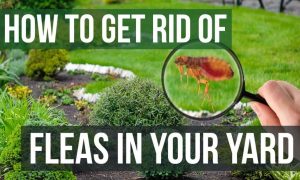Flea and tick infestations can turn your beautiful yard into a battleground. These tiny pests bring discomfort, disease, and distress to both pets and people. Nobody wants to share their outdoor space with these bloodsucking nuisances. The good news? You don’t need toxic chemicals to fight back. Nature offers plenty of weapons in this war against unwanted pests. I’ve battled these critters in my backyard for years. Through trial and error, I’ve discovered what works. Let’s explore practical, natural solutions on how to get rid of fleas and ticks in your yard naturally. Ready to reclaim your outdoor space? This guide will show you how.
Natural Ways to Get Rid of Fleas and Ticks
Treat the Yard

Fighting fleas and ticks starts with treating your entire yard properly. These pests hide in many places you might not expect. Diatomaceous earth works wonders as a natural treatment option. This powder consists of tiny fossilized remains that cut through pest exoskeletons. Sprinkle it generously across your lawn, especially in shady spots. Beneficial nematodes offer another natural approach worth considering. These microscopic worms hunt down and kill flea larvae in the soil. They work without harming plants, pets, or people.
Nematodes come in spray form for easy application across your yard. Cedar oil serves as another powerful natural repellent against these pests. Mix a few drops with water in a spray bottle for targeted application. Many garden stores sell ready-made cedar oil sprays specifically for this purpose. Apple cider vinegar mixed with water creates an effective treatment for yard perimeters. The strong smell drives away ticks and fleas without harmful chemicals.
Remember to reapply these treatments after heavy rain for continued protection. Consistency matters more than quantity when fighting these persistent pests. The combination of several natural methods typically works better than relying on just one approach.
Create a Barrier
Creating defensive barriers helps keep new pests from invading your yard. Think of it as building a moat around your castle. Food-grade diatomaceous earth makes an excellent barrier when applied in bands. Spread it in a three-foot perimeter around your entire yard as a first line of defense. This natural powder creates an impassable zone that pests avoid crossing. Crushed herbs like rosemary and lavender work surprisingly well as barrier materials.
These fragrant plants naturally repel fleas and ticks with their essential oils. Sprinkle dried herbs along fence lines and property boundaries for added protection. Wood chips soaked in cedar oil create longer-lasting physical barriers. Place them between your yard and wooded areas where ticks commonly live. Regular reapplication keeps these barriers effective throughout flea and tick season.
Many homeowners forget to protect entry points like gates and walkways. Don’t overlook these crucial areas when establishing your defensive perimeter. Combining several barrier methods creates a more robust defense system against these pests. Natural barriers work best when maintained consistently throughout the warm months.
Mow the Lawn
Proper lawn maintenance forms a crucial part of natural pest control. Fleas and ticks hate short grass with good sun exposure. They lose their hiding places and become vulnerable to dehydration. Keep your grass at the recommended height for your specific variety. Most residential grasses should stay between two and three inches tall. Mow regularly rather than letting grass grow tall between infrequent cuttings.
This consistent maintenance disrupts the life cycle of developing fleas. Bag your clippings after mowing instead of using the mulch setting. Flea eggs and larvae often hide in cut grass and thatch. Remove this material completely from your yard for better pest control. Morning mowing works better than evening cutting for pest management purposes. The hot afternoon sun will then dry out the freshly cut lawn, creating hostile conditions for pests.
Don’t forget the edges where lawn meets fencing or garden beds. These transition zones often harbor the highest concentrations of fleas. Use a string trimmer to maintain these areas at the same height as your main lawn. Regular mowing disrupts the humid, shady conditions these pests need to thrive.
Apply Cedar Mulch
Cedar mulch offers dual benefits for your yard and gardens. This natural material beautifies your landscape while fighting pests. The oils in cedar naturally repel many insects, including fleas and ticks. Apply a three-inch layer around trees, shrubs, and in garden beds. This thickness provides optimal pest control while supporting plant health. Replace old mulch yearly to maintain its repellent properties against pests.
Fresh cedar contains more active oils that drive away unwanted insects. Cedar mulch works particularly well in shady areas prone to flea infestations. The combination of cedar scent and drier soil conditions deters pest development. Consider mixing in some beneficial nematodes when applying fresh mulch. This one-two punch attacks pests at multiple life stages simultaneously. Local garden centers often carry cedar mulch specifically marketed for pest control.
These specialized products may contain higher concentrations of cedar oils. Some homeowners report better results using cedar chips rather than shredded mulch. The larger pieces seem to retain their repellent properties longer in outdoor settings. Remember that cedar mulch alone won’t solve an existing infestation. It works best as part of a comprehensive natural treatment plan.
Trim Limbs and Shrubs
Overgrown vegetation creates perfect hiding spots for fleas and ticks. These pests thrive in damp, shady areas with minimal air circulation. Start by trimming tree limbs that block sunlight from reaching your lawn. More sunshine means drier soil conditions that discourage pest development. Maintain at least six inches of space between shrubs and your house. This gap reduces pest movement from vegetation into your home.
Thin out dense bushes to improve air circulation throughout their branches. Fleas and ticks hate the drier conditions created by good airflow. Pay special attention to areas where pets frequently rest or play outdoors. These zones typically need more aggressive vegetation management for pest control. Remove any brush piles or yard debris promptly after trimming activities.
Such collections of organic material quickly become breeding grounds for pests. Consider replacing some dense shrubs with pest-repellent plants like lavender or rosemary. These aromatic options beautify your landscape while naturally fighting fleas and ticks. Regular pruning maintains not just plant health but also creates a less hospitable environment for pests. The effort invested in proper vegetation management pays dividends in reduced pest populations.
Risks of Having Fleas in Your Yard

Flea infestations bring serious health concerns for both pets and people. These pests spread diseases like typhus and bartonellosis through their bites. Even a “mild” infestation can cause intense itching and discomfort. Pets suffering from flea bites often develop hot spots and skin infections. Certain animals and people may experience severe allergic reactions to flea saliva. This condition, called flea allergy dermatitis, causes intense suffering.
Children playing in infested yards face higher risks due to their ground-level activities. The diseases carried by fleas can cause fever, headaches, and more serious symptoms. Property values may even suffer when yards become known for persistent pest problems. Ignoring early signs allows populations to explode into overwhelming numbers. What starts as a few fleas can multiply into thousands within weeks.
Neighboring properties often suffer as fleas migrate in search of new hosts. This creates community tensions and potential liability issues. Wildlife visiting your yard can bring new fleas, perpetuating the cycle. Breaking this pattern requires prompt action against existing pests. The financial costs of treating pets, homes, and yards increases with infestation severity. Acting early with natural methods saves money and prevents unnecessary suffering.
How long does it take to get rid of fleas?
Eliminating fleas completely requires patience and persistence. Most natural treatment plans take between two and three months for total eradication. This timeline accounts for all stages of the flea life cycle. Eggs and pupae resist most treatments and must mature before becoming vulnerable. You’ll typically notice significant improvement within the first two weeks. Adult flea numbers drop first, reducing the immediate biting problem.
Consistent application matters more than finding a “perfect” natural remedy. Missing even one treatment can allow populations to rebound quickly. Seasonal factors affect how quickly your yard becomes flea-free. Summer infestations generally take longer to eliminate than spring or fall ones. Temperature and humidity directly impact both flea reproduction and treatment effectiveness.
Yards with heavy shade or poor drainage may require extended treatment periods. The presence of wildlife hosts can also extend the timeline for complete control. Regular monitoring helps track progress and adjust your approach as needed. Look for signs of improvement rather than expecting overnight results. Complete elimination happens gradually as successive generations fail to develop.
The good news? Natural methods provide sustainable long-term control once established. Your dedication during the initial months creates lasting protection against future infestations.
Conclusion
Taking back your yard from fleas and ticks doesn’t require toxic chemicals. Natural solutions work effectively when applied consistently and comprehensively. Start by treating your entire yard with diatomaceous earth or beneficial nematodes. Create protective barriers, maintain your lawn properly, and use cedar mulch strategically. Don’t forget the importance of trimming vegetation to reduce hiding spots.
These efforts require some persistence, but the results justify the work involved. Your family deserves a safe outdoor space free from biting pests and health risks. The natural approaches in this guide protect not just your yard but the wider environment too. Beneficial insects, soil health, and water quality all benefit from avoiding harsh pesticides.
Next weekend, why not start your natural pest management plan? Begin with just one of these methods and build from there. Your pets will thank you for the itch-free playtime. Your kids will enjoy worry-free outdoor adventures again. With nature as your ally, you can win the battle against fleas and ticks for good.
Also Read: How to Build Authentic Connections in Real Estate
FAQs
Yes, vinegar’s strong smell deters these pests effectively. Mix equal parts water and apple cider vinegar for best results.
Apply every 7-10 days and after rainfall for maximum effectiveness against fleas and ticks.
Absolutely! These natural solutions are safe for families when used as directed.
Yes, comprehensive pest management should include treating both your yard and your pets.



